We bring you the highlights from European Researchers Night 2009, which filled the Great North Museum with explosions, music and laughter. We meet Brainiac's Jon Tickle to discuss the physics of custard, find out why My Little Ponies belong in a museum and explore the murder mystery of the Lindow Man. Also, how embryology inspired fashion design and how Spanish rocks point to North Sea oil. Plus, we rock out with the Punk Scientists...
In this episode
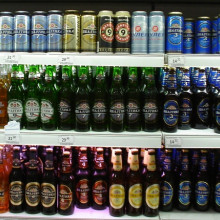
Alcohol and Risk in the Adolescent Brain
For a long time, we've known that people who abuse alcohol tend to be very bad at making decisions and particularly gambling-type decisions weighing up options: "Should I take the gamble and go for a big possible win or should I take a sure fire smaller win?" Research published in the Journal PNAS this week looks at the question of alcohol and alcohol abuse.
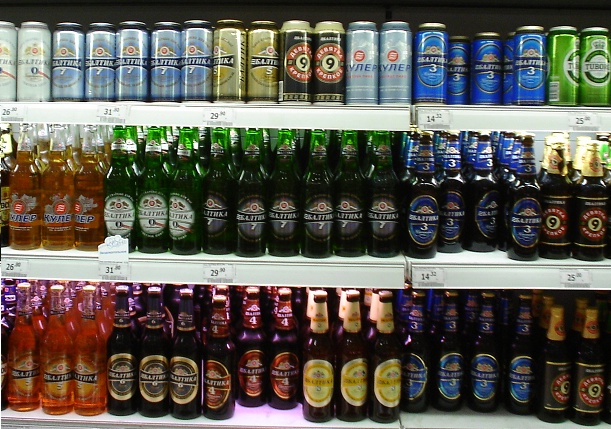 The big question is, do people who are prone to drink too much also prone to make bad decisions? Or does the alcohol make them more prone to make bad decisions?
The big question is, do people who are prone to drink too much also prone to make bad decisions? Or does the alcohol make them more prone to make bad decisions?
A group of researchers at the University of Washington in Seattle, Nicholas Nasrallah and his colleagues, decided to set out to answer that question.
This study used rats because, obviously, it would be rather unethical to try and use the human teenagers they're interested in trying to understand. But they wanted to assess the effect of alcohol on the developing brain and rats are a very good model for how human brains make decisions. The only slight snag is that, unlike teenagers, you can't get teenage rats to want to drink too much so they found a way around the problem. They developed the rodent equivalent of vodka jelly which these rats will imbibe and this led to a sustained high intake of alcohol over a period of time in these rats.
After they have given these adolescent rats the alcohol-impregnated gel for a period of time they gave them a gambling task to do. So the rodents were made slightly hungry so they want to participate in the research, which involves giving them food rewards and they offer them a choice. The first choice is they can have a small outcome, two food pellets, but they'll definitely get it. Alternatively, they could have a high-risk gamble and they may get four food pellets. But the more times that they do the trial, the less and less likely they are to get those four food pellets.
Now if you do this with normal animals that have not been exposed to alcohol, they quite quickly cotton on to the fact that they might do quite well to start with, but later, it's much better to take the sure fire win situation because you're going to get something - you're not going to get left with nothing.
But these rats that have been exposed to alcohol, consistently, time after time, made the wrong decision. They couldn't learn that if they kept taking the gamble, it was going to have a bad outcome and they kept going for the high-risk outcome and in the end became croppers as a result. Now this isn't just because they weren't drinking alcohol at the time, this was in some cases up to three months after the exposure to the alcohol had stopped.
The researchers suggest that the alcohol is in some way affecting how the teenage brain is wiring itself up. Maybe it's triggering a condition called perseveration, which is where the brain struggles to size up the scale of the problem and then change its behaviour accordingly. It's almost like the brain gets locked into one path of action and finds it very difficult to add additional variables or parameters so that it changes its outcome. But it's very informative because it says to us, look - if we're not careful with young humans, if they take sustained exposure to alcohol as many are doing, then it could be that they are changing the way that their brain works. And they're going to be cruising for a cognitive bruising later because this will lead them to, maybe make those decisions when they're older.
It's important not to confuse this with a social drink of "watered down wine" with the family at dinner on a Sunday because that kind of alcohol exposure is almost certainly not going to have such an effect. The animals in the study where being exposed to what would equate to quite sustained heavy drinking: the kind that you see in nightclubs that you have to actually try quite hard to achieve.
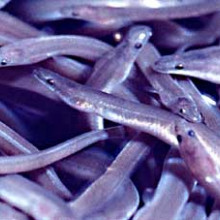
The Mighty Eel Migration
There are two really interesting papers this week on migration; one of which looks at eels. Eels are a hot topic because, as well being the thing that you put in jellied eels and which many people find very, very tasty, eels are in decline. Their numbers have gone down enormously in recent years and they're actually an animal which we know very little about but they make huge migrations across the oceans. They go 5,000 kilometres from Europe, all the way across to the North Atlantic to a place called the Sargasso Sea, which is where they mate and reproduce. If we are to try and conserve this species, we need to understand how they do that, how they make this journey and what the parameters of that journey are. Because if we don't understand anything the species, how can we save them?
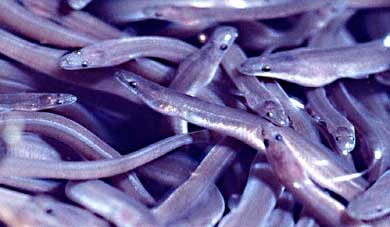 Unfortunately there are problems with tracking a fish which swims about underwater, sometimes a thousand metres underwater.
Unfortunately there are problems with tracking a fish which swims about underwater, sometimes a thousand metres underwater.
A group of researchers at the Technical University of Denmark: Kim Aarenstrup and her colleagues have a paper in Science this week. They've built very small satellite transceivers which they can put onto the eels. They released 22 eels in the West Coast of Ireland and let them swim off in November 2006. Every time these eels surfaced, the satellite transceivers would upload data on where the eel was, its position, where it had been in the water column and details about water environment that it was experiencing on its way.
They then reconstructed some of the eels' journeys to a distance of about 1,300 kilometres: a quarter of the way towards the Sargasso Sea.
And now we have some of our first insights into how they do this. The really interesting part is that these eels, after they depart, travel about 25 kilometres a day. But the researchers say that's actually too slow to get where they need to go by April, which is when they need to go to Sargasso Sea to mate.
So what are they doing?
The researchers suggest that what they do is swim down to Africa and then hitch a ride on a fast-moving ocean current which helps them to speed up and get the rest of the way much more quickly.
But one of the really intriguing bits of data was that the eels change their height in the water column between day and night. So during the daytime, they swim much deeper. They go down to about a thousand metres and at night time, they come up close to the surface.
Now, lots of animals do this because they come up at night time to warmer water to feed. But eels don't eat anything on their way to Sargasso Sea.
So why are they doing it?
The researchers think the warmer water closer to the surface is bad news because it speeds up the eels' metabolism and it makes them mature faster - because they need to make sure they're reaching sexual maturity when they reach the Sargasso Sea to mate. So by swimming along most of the time at deeper water and therefore lower temperatures they're actually slowing down their development and this means that they're in a position to be just in the right place, at the right stage of development. So when they get to the Sargasso Sea, they can mate. So it's an intriguing bit of research.
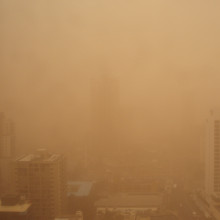
Caught in a Dust Storm
For this week's news, we caught up with Chris Smith shortly after his return from Australia...
Chris - I was in Australia because I went there to give a talk in Brisbane which is at the conference and that which it's about halfway up the east coast of Australia. And then I flew down to Adelaide, which is down in the bottom in the middle of Australia, to give a talk there and to do some interviews for some people. 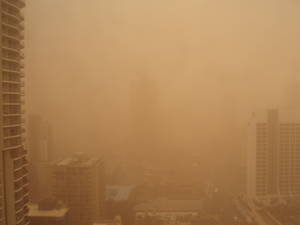 Then I went over to Sydney to see some friends of ours at the ABC, the Australian equivalent of the BBC. And I woke up on a Wednesday morning and I thought I've gone mad. Because when you first wake up, you're not sure if your brains are actually playing tricks on you? When I woke up in the room, it was orange. No. There's something funny about this and I went back to sleep. And I woke up again about 10 to 15 minutes later, and now the room really is orange and I thought the city was on fire. This funny colour that was coming into the room and I ran to the window and I looked out and I couldn't see the end of the street. The whole street was bright, orangey red and the cars were orange. It was like a very dense fog but bright red.
Then I went over to Sydney to see some friends of ours at the ABC, the Australian equivalent of the BBC. And I woke up on a Wednesday morning and I thought I've gone mad. Because when you first wake up, you're not sure if your brains are actually playing tricks on you? When I woke up in the room, it was orange. No. There's something funny about this and I went back to sleep. And I woke up again about 10 to 15 minutes later, and now the room really is orange and I thought the city was on fire. This funny colour that was coming into the room and I ran to the window and I looked out and I couldn't see the end of the street. The whole street was bright, orangey red and the cars were orange. It was like a very dense fog but bright red.
And it turns out that what was happening was a very big storm over central Australia and the south part of Queensland, the state higher up the coast of Australia above Sydney had whipped up enormous amounts of top soil. And the top soil in Australia is very rich in iron oxide - rust, and that's why it's very red. And in fact, when measurements were made, it turns that this storm was dumping 75,000 tons of dust...
Ben - Wow.
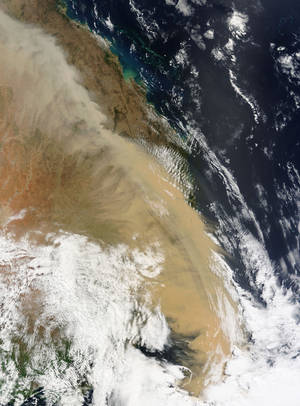 Chris:: ...into the ocean every hour, that it was blowing this 600-mile long dust storm across Sydney. Sydney was right in the path of it. It did clear by lunchtime on Wednesday but I just heard from my friend Robin Williams who presents the Science show - the flagship Science Show in Australia and he said the dust is back today...
Chris:: ...into the ocean every hour, that it was blowing this 600-mile long dust storm across Sydney. Sydney was right in the path of it. It did clear by lunchtime on Wednesday but I just heard from my friend Robin Williams who presents the Science show - the flagship Science Show in Australia and he said the dust is back today...
Ben - Oh no!
Chris - ...and this time it's brown. Not very nice and it presumably comes from a slightly less ionic oxide, rich bit of Australia this time. But certainly wary, they've never seen anything like this for more than a hundred years.
Ben - The photos I've seen were very incredible. It must have been very surreal.
Chris - It was pretty weird when normally, the temperature there should be nice and high. It should be clear and sunny and to be driving to work in that. And it was very unpleasant because it got into other buildings and you'd be sitting trying to have a conversation with somebody and every time you took a breath in to sort of breathe to speak, you'd feel this sort of cloying heaviness in the back of your throat because it was so dry, and it was very unpleasant. Lots of people ended up going to hospital with respiratory problems being exacerbated by the dust. The one benefit though was it actually made riding in the lift, which was air-conditioned. A lot more pleasant because it was the one place where the air was actually okay.

13:55 - European Researchers' Night and the Brains of Brainiac
European Researchers' Night and the Brains of Brainiac
with Dr Paula Martin, Durham University and John Tickle, Braniac
Ben - To find out more about European Researcher's Night, I spoke to Dr. Paula Martin from Durham University. She has worked tirelessly for months to bring Researchers Revealed together. She has be en organizing guests, researchers and the fantastic venue for the opportunity to take research out to the public. Along with Jon Tickle, who was a one-time Big Brother contestant and now presenter on anarchic science TV show Brainiac, I caught her in a quiet moment between shepherding school children around and setting up the stage. And I just wanted to find out how Durham University first got involved...
en organizing guests, researchers and the fantastic venue for the opportunity to take research out to the public. Along with Jon Tickle, who was a one-time Big Brother contestant and now presenter on anarchic science TV show Brainiac, I caught her in a quiet moment between shepherding school children around and setting up the stage. And I just wanted to find out how Durham University first got involved...
Paula - Researchers' Night has been happening across Europe for the past five years now and we have a lot of people who work for Durham University who have worked in European institutions previously and have been involved in the event in other countries and came to us and said, "Why is this not happening in the UK?" And so, we went ahead and got involved and now, it's happening here in the UK. We're the first university to be involved and we're delighted to be a part of it.
Ben - And you've put a European theme on the evening as well.
Paula - Yes. So this evening there'll be cities across 30 countries in Europe, all running similar sorts of events, opening their doors and encouraging members of the public to come along and find out more about the research that's going on in their local area. So we've got a big group of researchers from Durham University coming along to talk about the research that they do and also their personal interests and really anything that they're passionate about. And so, we have people who are going to be talking about astronomy and earth sciences and archaeology and social sciences, and art and music and sports and just a whole range of things. They're so excited about the chance to come out and talk to people about the stuff that they really do love doing.
Ben - Our regular listeners will be familiar with Dave Ansell's Kitchen Science. He's on stage doing, perhaps the slightly more dangerous stuff that you wouldn't recommend people to do at home. Who else do we have lined up?
Paula - So we also have Helen Storey who is a fashion designer, who has done a variety of collaborations with scientists to develop the art and fashion that she's interested in. And then, we'll be rounding off the evening with a comedy set by the Punk Scientists.
Ben - And the glue holding the whole evening together is in fact Jon Tickle who first rose to fame on British television on Big Brother and then of course, you led on to entertain and educate us through Brainiac...
Jon - Edutainment, yes.
Ben - Edutainment, which is - it's anarchic, it's fun but at the same time, there is still definitely something to learn from it. How did you get into Brainiac?
Jon - I was very, very lucky actually. I positioned myself on Big Brother as, not intentionally, but that's how it came out, as a bit of a geek. Hopefully, one who is technically aware rather than socially inept - there are two different definitions in the dictionary and I choose the one that suits me, but the executive producer of Brainiac was working up the show at the time. And bless Richard Hammond, but he's not the most scientifically versed person in the world. He loves science but he's not very knowledgeable and so, there was a need to fill in a section in the script, which explained the science. And so, there was a sidekick role going begging. And luckily, Richard thought of me and I got the gig and never looked back really.
Ben - And on Brainiac, they have you doing far more than just a filling in the science gaps. You're explaining some of the detailed science behind the big, messy experiments. You do walking on custard and it's your favourite one...
Jon - Yes.
Ben - Come back to that in a minute. But also you're looking at things that your body can do and you seem to be taking on the science questions from anybody who's willing to ask them, which is a very brave thing to do.
Jon - Oh, this is the very nice thing about the show. That very quickly we achieved a critical mass and so, we had lots of questions coming in, not only from the regular audience you might expect in terms of school kids and young people, but actually from all ages. And there are limits to the kind of questions you can answer in a 3 minute item on a television program. But we do try and address them by doing what some people can't do, which is getting out there and doing experiments. And very often, they're very simple ones. The best times on Brainiac were with a tray on a street corner, asking people to taste the difference between foods cooked with and without monosodium glutamate. And that's the kind of experiment you can do at home. It's just somebody has chosen to write in rather than do it themselves, but very pleased to demonstrate science in action.
Ben - It's fantastic to be able to give people the answers that they are looking for. Obviously, there are sometimes questions that we can't answer but more importantly, there are no stupid questions. Nothing is a silly question to ask.
Jon - No. This is one of my axioms. I'm absolutely passionate about that. There is absolutely no such thing as a stupid question. There is a simple question for me to answer, but there is nothing that I will ever deride when somebody asks me a question. So, there's no shame in asking what you might think is a simple question. The simplest questions are often the best ones and that's what Brainiac tries to do. We try to answer those questions but also explain how you might go about finding out those answers for yourself.
Ben - So you're encouraging a certain way of thinking.
Jon - Yes. We don't do high science as such, but what we do and try to do is encourage a scientific method. And this is something that you know, changed my life as a teenager - the understanding that you can ask a question and go about finding an answer in a structured, rigorous, real way rather than just believing anything that somebody tells you. It's very powerful and it's something I use at work all the time.
Ben - And that realization as a teenager led eventually to you walking on custard?
 Jon - Yes, it did, yes, one of my favourite experiments on the show. And certainly, when I speak people on the streets or in bars that's the one they always bring up. It was a fabulous experience, not least because I got to go to Richard Hammond's house. That was actually his pool that it was filmed in, he has a very nice pad out at Gloucestershire. Unfortunately, there was a downside to the day in that like most Brainiac experiments, it was filmed during the dead of winter. I think this was February so I had to dive into a pool of water to start off the experiment to prove that I couldn't walk on water. And so, I think we needed three takes of me, jumping into a 2-degree swimming pool.
Jon - Yes, it did, yes, one of my favourite experiments on the show. And certainly, when I speak people on the streets or in bars that's the one they always bring up. It was a fabulous experience, not least because I got to go to Richard Hammond's house. That was actually his pool that it was filmed in, he has a very nice pad out at Gloucestershire. Unfortunately, there was a downside to the day in that like most Brainiac experiments, it was filmed during the dead of winter. I think this was February so I had to dive into a pool of water to start off the experiment to prove that I couldn't walk on water. And so, I think we needed three takes of me, jumping into a 2-degree swimming pool.
Ben - They didn't heat it for you?
Jon - No, no! This is a bone of contention with me. We arrived for the shoot on the previous night and we were in a hotel having drinks in the bar and Mr. Hammond swore to me that he'd switched on the heating. And I believed him before I jumped in the first time. But obviously, he wasn't going to heat 27,000 litres of water, just so he could drain it five minutes later and fill it up with custard. So yes, it was absolutely freezing. I had hypothermia I'm sure afterwards.
Ben - And how long did it take to mix?
Jon - Oh, oh, all day, all day. The Brainiacs are mainly quite stupid individuals and that's not something we make up for the show. They really have very little common sense between them. And so, they hadn't brought enough custard powder with them. And so, we had to send vans, all around the west and southwest of England that day in order to empty, I don't know where you find warehouses full of custard powder but they at least got it done. And so, we had vans coming in all day, filling up the swimming pool. It took most of the day to film. We usually film two or three or even four experiments a day with Brainiac, but that was an experiment that took all day to film.
Ben - Fantastic. And what is coming up for you in Brainiac or indeed anything else?
Jon - Well, Brainiac is unfortunately dead now. We last went in front of the camera two years ago although you can still see repeats. I'm still doing things in the science communication arena like today. So, very pleased to be involved in the program tonight. But for me, at the moment, I'm trying to concentrate on my career and further my proper career, I always call it. I'm a software designer.
Ben - And this is something that most of the people don't know about you. That actually all of the Brainiac stuff, you do in your holiday.
Jon - Yes, since Big Brother, I haven't really had a proper holiday. Actually, I had my gallbladder out about three months ago and that was the first time I've had two weeks off work for six years. It was a very pleasurable experience for me despite what it might going to sound like! Yes, so normally, I spend my 30 days holiday a year doing things like this, trying to further the aims of science communication.
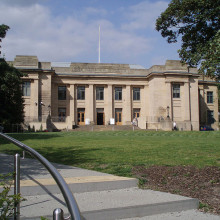
22:14 - The Great North Museum
The Great North Museum
with Steve McLean, Senior Manager, Great North Museum
The Great North Museum was open to the public throughout Researchers' Night, offering a rare chance to see the museum after dark. To find out more about the museum itself, I spoke to the Museum's Senior Manager, Steve McLean.
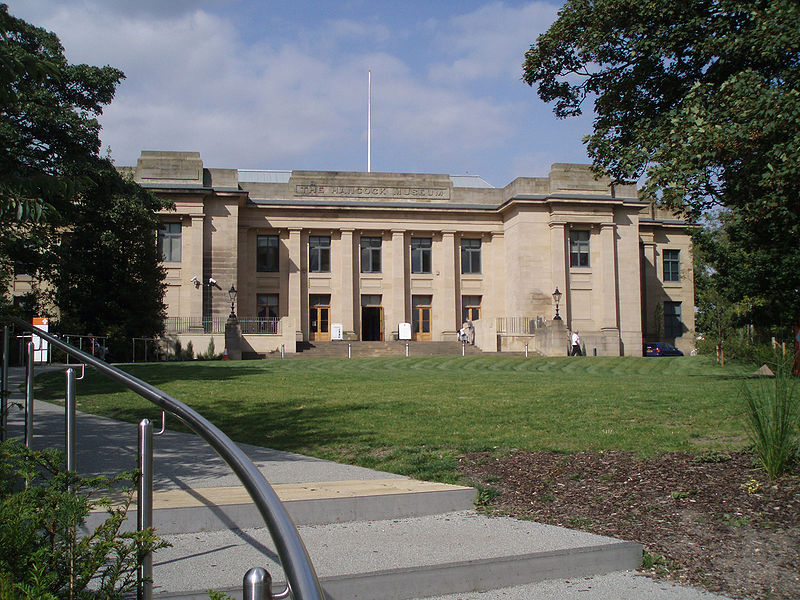 Steve - Well the Great North Museum is a bringing together of a number of museums in Newcastle University. It's divided into three different sites. We're in the Great North Museum Hancock at the moment, which is where three collections have come together--the original Hancock Museum, the University's Museum of Antiquities and Shefton Greek Museum in the university. All now come together under one roof to create this spectacular, new multi-disciplinary museum. So in the past, the Hancock used to be mainly natural history and some Egyptology, now it's natural history including geology, fossils, crystals, gems. We've also gotten huge collections of archaeology, Hadrian's wall material, prehistoric collections and of course, our Egyptology and world cultures collections as well. We've just reopened, about four months ago in May, after a 3-year re-development, which cost just over 26 million pounds.
Steve - Well the Great North Museum is a bringing together of a number of museums in Newcastle University. It's divided into three different sites. We're in the Great North Museum Hancock at the moment, which is where three collections have come together--the original Hancock Museum, the University's Museum of Antiquities and Shefton Greek Museum in the university. All now come together under one roof to create this spectacular, new multi-disciplinary museum. So in the past, the Hancock used to be mainly natural history and some Egyptology, now it's natural history including geology, fossils, crystals, gems. We've also gotten huge collections of archaeology, Hadrian's wall material, prehistoric collections and of course, our Egyptology and world cultures collections as well. We've just reopened, about four months ago in May, after a 3-year re-development, which cost just over 26 million pounds.
Ben - That's a decent chunk of investment.
Steven - So, yeah, an awful amount of money brought together but also we've created a new store and resource centre where all the stored collections are being held because in this building are only the displayed collections now. So we've got a new facility where researchers can come and look at the collections or we can take school group parties around, and we've got classrooms there as well. So the collections themselves, which of course are the backbone of the museum, are now much more accessible for visitors and researchers to use.
Ben - It must be quite a challenge to tick all of the relevant boxes of natural history and Egyptology, and... As you said, it is very multi-disciplinary. You can probably tell from the background noise that we're near the natural history part at the moment, with whale song and bird calls and so on but how do you gel all of these fairly disparate parts together?
Steven - It's a challenging process I have to say. I mean we obviously, throughout the process we worked with architects and exhibition designers. We did a lot of research on how we want to interpret the collections and we came with a model for how we would do that. But you know, like all museums, we're trying to be all things to all people and that does present its challenges. We're also a University museum but we are run by Tyne & Wear Archives Museums, the largest local authority museum service in the country. And we've got a huge family audience out there but we've also got to service the students at the university and other universities as well. So, it's a challenge to try and make that all work and we did deliberately try to set out series of exhibitions and galleries in the museum that complemented each other but also operated in a number of different ways. So you've got galleries that are a little bit more contemplative, quieter, slightly more academic perhaps and then you've got galleries like this gallery which is the living planet gallery which is a little bit more razzmatazz, very dramatic displays, sound effects and so on, trying to create lots of different environments and fields so that all sorts of visitors can get something from the museum. That's what we're trying to achieve. Now, there's always somebody that you can't please but we've had nearly half a million visitors into this museum since we opened and the overwhelming response has been positive. So we think - we think we've got it right but that doesn't mean to say we won't continue to develop and improve the museum. We're here to continually do that and to challenge ourselves, and try and move things forward. So, it's a never-ending process to keep, you know, keep things moving on.
Ben - One of the parts of the museum which should have quicker turnover than the rest of course is a temporary exhibition space you have to move towards the back of the museum, which currently I've been told the houses a decomposing body.
Steve - Aha! Yes. Well, we are lucky enough to have a really fabulous relationship with the British Museum. In fact, we developed the main Egyptology display here in the museum with a long-term loan from the British Museum so we're able to show part of the National Collection here in Newcastle. We also have worked with the British Museum through their UK partnership scheme to bring prestigious objects up to the Northeast and we've had some fantastic exhibitions from the BM like the Buried Treasure Exhibition, which contains some of the nation's most famous gold and silver treasures as well as various other items. And the latest object we've got is Lindow Man, the famous bog body, probably the most famous bog body in the country. So a very prestigious loan from the BM and we're really pleased that we can house these sorts of objects here because we've built the facilities, working with the British museum and so on, to make sure the facilities are appropriate for their collections. So we do really now have a very much an international exhibition venue here that allow us to bring in these top quality objects so hopefully the people, particularly in this region, will see the benefit of that.
Ben - With such a range of things, this might be very difficult question but, what's your personal highlight?
Steven - It is a difficult question. I mean in a past life, I was a geologist and mineralogist before I became a manager so I do have a leaning towards palaeontology, that's my own love. And really the objects that I am most interested in are the famous Newsham beasts, which are large crocodile-like amphibians from the Carboniferous period, which inhabited the swamps of what is now Northumberland around 320 million years ago or so and they were critical in our understanding of the evolution of tetrapods, four-footed animals, and ultimately our own evolution. So, they play a pivotal role in our understanding of vertebrae evolution and are one of four or five collections of these animals in the world. We've got some of the type specimens which are the original specimens that were used to describe the species so they're internationally significant and we've been able to put them on display, because normally their hidden away in secure stores. But because we've have this re-development, we've been able to put a lot of investment into high quality secure cases and therefore, we've been able to put some of these wonderful materials on display. So people are now seeing the really, really important material in the collections. So for me, that's one of the wonderful things to see in the museum. However, I have to say that one of the galleries, our explore gallery, which is all about collecting and collectors and classifications of why we as the species have this desire to collect and classify the world around us. I asked my own children to find something that they collected. So there's a drawer in there with five My Little Ponies and they would argue they're the most important things in the collection. But there's so much material and it means something to different people at different levels. And everybody's got their own favourite items. Of course, everybody loves the T. Rex, of course...
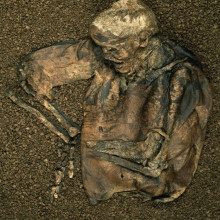
28:40 - Lindow Man
Lindow Man
with Dr Sarah Glynn, the Great North Museum
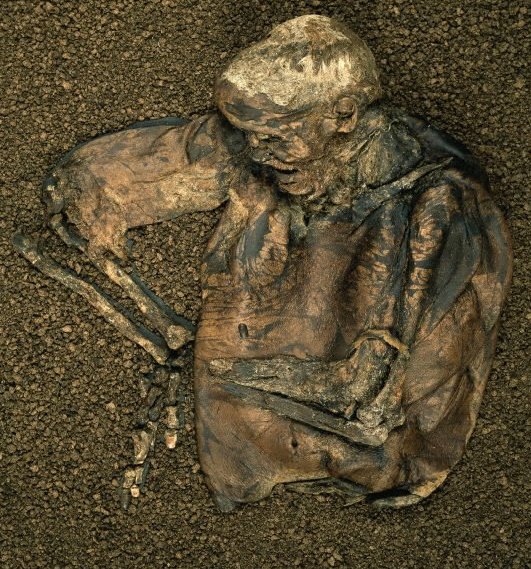 Now the temporary exhibit that Steve McLean mentioned, the Lindow Man sounded fascinating. So Meera Senthilingam met Dr Sarah Glynn, who's another Manager at the Museum, to find out the history behind this amazing exhibit.
Now the temporary exhibit that Steve McLean mentioned, the Lindow Man sounded fascinating. So Meera Senthilingam met Dr Sarah Glynn, who's another Manager at the Museum, to find out the history behind this amazing exhibit.
Sarah - Well, Lindow Man is Britain's most important and most complete bog body. He was found 25 years ago in Lindow Moss which is in Cheshire in Manchester. And he was found by peat cutters who were cutting the peat in the Moss, originally he was found because one of the cutters was throwing something off the conveyor belt that they thought was just a log. It turned out to be a leg. The police, the archaeologists were all brought in, and Lindow Man was taken out in a full piece of peat and excavated in the lab in London. He was a very heavily forensically researched. We can tell loads about his final days, his final hours, how he died. We know that he suffered three key injuries. He has a blow to the head. He has a garrotte or a sinew round his neck may have been used as a garrotte. He also has a broken neck and he also has some potential stab wounds.
Meera - That's quite a death.
Sarah Glenn - Yeah, quite, quite a nasty way to go. We know that the blow to the head didn't kill him because CT data shows that his brain had started to heal. His head had swollen and bruised basically so he must been alive for enough hours for that to happen. And the work eventually showed, that it was the fracture to the neck which was the fatal injury. The interesting thing about Lindow Man is that we know already his detailed items about how he died. What we don't know is why did he die? Was it a ritual sacrifice? Was he executed as an example to the community? Or was he just a really unfortunate murder?
Meera - So how would scientists go about finding that out?
Sarah - Well, archaeologists and the forensic scientists still study Lindow Man up until the present day. At around the time that Lindow Man died, there are quite a lot of bog bodies across Western Europe and often they have suffered three deaths as it were so similar to Lindow Mans three significant injuries and even things like swords that were thrown into bogs as offering to the gods. They were sometimes killed three times so they might be bent three ways. We don't know exactly what this all meant but it was clearly something quite significant.
Meera - Yeah, it's a very interesting pattern.
Sarah - And it's certainly, for me, the strongest argument for why is probably a ritual sacrifice but we can't be sure and we can never be sure because there are no written records from the time. But what we do know is that Lindow Man was very well looked after physically. So he has manicured fingernails, he has hair that has been cut into a very fetching mullet and he was probably about 25 years old.
Meera : How are you using the exhibition here then to teach the people about Lindow Man and what the science involved in finding out about his demise and his life is about.
Sarah - Well, this exhibition is all about as presenting the visitors with the evidence that we've got and asking them to make up their own minds about how he died. We've even got some cutting edge technology which was developed by Newcastle University's Culture lab department and which is a multi use of touch table and you can investigate in details some of the forensic data that was collected at the time: x-rays, CT scans. You can even run simulations to see particular weapons in action so can decide for yourself what might have killed him. And really, because we don't know, we're throwing it open to our visitors to say here's the data, you decide. You make your interpretation, which is just as valid as those of the archaeologist and the forensic scientists.
Meera - That's a nice touch to think that they could help contribute to a quite complex mystery.
Sarah - We really want to involve our visitors in our exhibitions and particularly for this where we just don't know. It's a wonderful way of doing it.
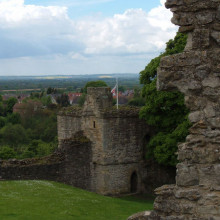
32:42 - Protection from Flooding
Protection from Flooding
with Dr Nick Odoni, Durham University
One of the aims of Researchers' Night all across Europe is to put people in touch with researchers whose work could directly affect their lives. Dr Nick Odoni is a very good example of this as his research looks at ways to mitigate and avoid flooding and in particular to protect the town of Pickering in North Yorkshire from the flooding it's so often prone to. Meera Senthilingam spoke to Nick to find out more.
Nick - Pickering is at the end of a melt-water gorge that was formed probably during the last one or two Ice Ages. The mean flow in Pickering beck is only a cubic metre per second or less over the year but occasionally you get really big storms over the North York Moors and the flow increases enormously, and there's a history there for flooding in Pickering when get these really big thunderstorms or really big slow moving depressions. And we had a big event in June 2007 when this 1-metre average flow was suddenly increased to over 30 cubic meters per second and the town was quite seriously flooded.
Meera - What is the first line of defence against this? Just to, kind of, barricade the town?
Nick - Well, you've got spot on. Normally, what would happen in this situation is we would think in terms of hard-engineered flood defences. Now this could mean various things. It could mean a bypass tunnel. It could mean making the channel deeper and wider. It could mean erecting hard concrete walls protecting the town say for two/two-and-a-half feet higher than the present banks of the river, extending some distance upstream or some distance downstream, or both. But there are two particular problems with these defence mechanisms. One, they're very expensive and two, they speed the flood wave downstream so you may protect Pickering but you may make it a lot worse for people further down the system.
Meera - What are your possible solutions to avoid this?
Nick - Well we're looking for something which might be cheaper and also more sustainable in the sense that it fits in more neatly with the natural environment. We are looking at low impact upstream storage and structures which will slow the flow. So as we farm the landscape, remove the trees, remove vegetation to a certain extent, the water speeds up very easily into the channels and that gives you a very sharp responsive system. So what we are trying to do is by planting trees, by planting buffer strips by building ponds, and in this particular example we are seeing today, by building a small dam, small bunds; 1 or 2, 3 meters high at most, we can stretch out the flood wave again. We can lower the peak and that's a much more sophisticated, but we hope sustainable way of preventing flooding in the town.
Meera - Now, are each of these different measures, so the planting of trees and the creating of ponds all equally important? So do you need the combination of all of these or some are going to make a bigger difference than others?
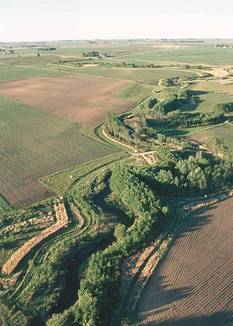 Nick - Some are going to make a bigger difference than others in theory. However, we have all the competing land uses and land management options to consider. So we have a national park. We have several SSSI's (Sites of Special Scientific Interest). We have multiple land users. We have the North York Moors railway. So although a scientific exercise might say, okay, bunds first then riparian buffer strips then ponds. We may find that for land use reasons, with the competing pressures, we can't do it that way so therefore we have to consider all of them.
Nick - Some are going to make a bigger difference than others in theory. However, we have all the competing land uses and land management options to consider. So we have a national park. We have several SSSI's (Sites of Special Scientific Interest). We have multiple land users. We have the North York Moors railway. So although a scientific exercise might say, okay, bunds first then riparian buffer strips then ponds. We may find that for land use reasons, with the competing pressures, we can't do it that way so therefore we have to consider all of them.
Meera - Now you have a model set up here on the laptop as part of the exhibition in order to get a better insight into how these possible solutions will work. So what do we have to do here?
Nick - Okay. What we've got here is a very simple bunding model. This is just one aspect to the things that we are looking at and the idea is that people can have a go at selecting places in the river network along Pickering Beck or the other tributaries in the catchments and saying I'm going to try a little bund there, and a little bund here and a little bund somewhere else. We can work out the storage volumes for bunds of different sizes. And by combining these, we can see how much storage can we get and therefore can we take off a critical amount of flow from Pickering and prevent flooding? Now, our target in this exercise is 10 cubic meters per second, 10 cumecs, so we have a flow which is theoretically 30 and we're going to try and reduce it to 20 for as long as we can. Can we get two hours protection? Can we get five? Can we get 20 hours of protection?
Meera - A question I'm not quite to understanding about the whole prevention of flooding is you manage to keep this away for hours, and then what?
Nick - Well, we know that probably seven hours isn't likely to be enough. The extent the flood into 2007 was more like 16 hours, and in terms of a volume of water, it was something like 400,000 cubic meters of water. We also know from our modelling here, that these two structures we've put in are giving us about 180,000 cubic meters of water. So we know we need to try other things. Now that might be more bunds or it might be some of these other measures like ponds or riparian buffer strips to further slow the flow. We can also consider the re-meandering the channels because by putting the meanders back into the network, the water travels more slowly and therefore again it attenuates the top of the flood wave. Finally, however, this is only an exploratory model. We must test these results rigorously using the standard engineering models that the Environment Agency use. But once they see our results they know where to test and they know what to test.
Meera - How transferable then do you think these solutions and these various methods of preventing flooding are for other towns in other geographical regions that are prone to flooding?
Nick - Generically, all of these ought to help to a certain extent but much will depend upon regional geology and land use and climate. For example, the Pickering system doesn't have much in the way what we called ground water flow. You might find on a chalk catchment or an area where there's a lot of limestone, we have to try different types of solution because there's so much more water coming from the ground. So, it's not perfectly transferable. But the idea is that you should use an exploratory model first such as this, and then go the more rigorous physically based models to work out the exact solution and the exact place.
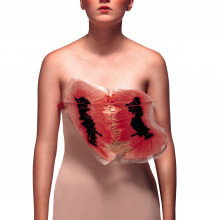
39:35 - Primitive Streak - Science Meets Fashion
Primitive Streak - Science Meets Fashion
with Helen Storey MBE, Helen Storey Foundation
Helen Storey is a fashion designer who was inspired by developmental biology to design a series of stunning and thought-provoking dresses. Meera met Helen in the Researchers Revealed auditorium to find out about the Primitive Streak Collection...
Helen - It's a collection that elucidates the first thousand hours of human life, going from fertilization through recognizable human form.
Meera - How did you go about coming up with this concept and how did you actually research it in order to know how to then design your dresses?
Helen - It was a gift from my sister [Professor Kate Storey], who was at the time at Oxford, she's a developmental biologist. She's now at Dundee and she noticed a call out that the Wellcome Trust to put up scientists and artists together to see if they can come up with unusual bodies of work that de-mystified the complexity of science and captured public imagination. So, that is what her invitation was and she asked me to go down to Oxford to look down her microscopes. And basically, what she studied was the first thousand hours of human life. And we worked with chicken embryos because chicken embryos are almost identical in terms of development to human embryos, and I was blown away by what I saw. So I was instantly inspired and tried to allow the science or the biology, if you like, to tell me what to do, which is also the reverse of being a fashion designer really. You have this sort of amazing narcissistic vision that you put out there, but this was very humbling. I had to do what the science told me to do.
Meera - And I guess you haven't created a thousand dresses for each hour, so how did you go about dividing up these thousand hours and what are the stages that you have shown to portray?
Helen - We ended up picking 11 key events because you're right, we couldn't do a thousand dresses. I relied on Kate really, in terms of her identifying the ones that she felt were the most important narrative, if for example, you're talking to an 8-year-old. So we worked out instantly that we wanted it to be understandable and accessible for somebody, some short person who might not even know what biology is. But, likewise, one of the things that's been quite amazing as we, one of the places we showed you was a National Trust castle in Scotland. And I had three elderly women in their 90s, looking around the collection and one of them began to weep and she said, "I had no idea that this is what was happening in my body all these years ago." So if you can do a body of work that manages to kind of, touch an 8-year-old and a 90-year-old, you are probably on to a good thing.
Meera - So what are these key stages?
Helen - So we have fertilization, implantation, neurulation, formation of the primitive streak, we have something called India streak, we have three different stages of heart development, limb development, and we end up with recognizable spine formation and formation of the ribs. And then, in cell division, for example again, we have three dresses that look at cell division in its different phases. So it's not 11 distinct ones where there is a natural progression, like in heart development, it took three to show us that.
Meera - So an event has actually just started in the auditorium. Helen, we've had to move outside, out into the main part of the museum into one of the exhibits but we brought your dresses here with us. Now this first one, it's beautiful. It's white and it's got lots of lace all around it and what is this portraying exactly?
Helen - It's part of the fertilization group. There were three pieces actually on that and this is the particular lace work that's been constructed from scratch, if you like. Two Japanese students from the London College of Fashion have embroidered each of the sperm heads. I don't quite know if there are a thousand, but I might be close to it. They embroidered it on to a backing which dissolves when it's put in water so it just leaves this rather beautiful lace work.
Meera - I guess that just shows how many sperm are needed in order to actually fertilize an egg.
Helen - I mean this is only a fraction but I suppose the fact because it's actually covered in it. That is just a colossal amount of sperm that it takes to fertilize one egg.
Meera - Now, say, that one's very kind of pure-looking and white. Now the other two we've got here are very red, a scarlet red. This first one, which has a kind of a black drawing essentially put into the middle, so which stage is this?
<img alt="Red Silk Spinal column dress" title="Red Silk Spinal column dress © Design by Helen Storey, Photo by Justine âEUR" model="" korrina="" @="" models="" 1"="" data-cke-saved-src="/sites/default/files/media/PS26.jpg" src="/sites/default/files/media/PS26.jpg" style="float: right;" width="427" height="524">Helen - That dress represents implantation and it's taken from a very, very early biological drawing and there's something about the handwork that I really liked. So we transferred that into embroidery and placed that on the front of the red dress. But in order to show how the embryo actually embeds into a uterus wall, you know, there is a boundary there of sorts, three-quarters of the side of it is in black chiffon. So if you like, the red part of the dress plugs into the black part of the dress. And what we try to show is that the outer layer of cells become placenta and the inner layer of cells will determine the body.
Meera - Now, this last one, I have to admit, I think, is my favourite because there's just a beautiful lustrous piece of velvet that just folded and curled over and runs the length of the mannequin. Is this the primitive streak?
Helen - It's not - this is actually a phase called neurulation, but it's quite close to primitive streak in terms of sequence of development, if you like. But the fold that you're talking about down at the back is the neural fold and then either side are symmetrical structures, amongst the first structures in the developing embryo known as somites. And all this dress represents I suppose, are the parts of the embryo that are destined either to become brain or eventually spinal cords and spine itself.
Meera - These various stages, I have to admit, they worked really well. I wasn't quite sure what to expect when I thought that dresses would be showing the first thousand hours of human life. And they depict it very well, but I'm now curious, because you don't have it here with you, what does the final stage look like, what does the final dress look like?
Helen - Well, the final dress in some ways was supposed to be slightly tongue-in-cheek. It's got a very beautiful but very obviously clear spine, and it's a cast of a female spine which has been cast and plated in silver foil. And then through it, we run 500 fibre optic fibres that run like very long hairs and when they're lit up, their sparkling effect, if you like, is supposed to be symbolic of the signalling that happens up and down the spine. And then the dress itself is a massive gown with a six-foot train on the back, and that again is in red and black and it shows a DNA sequence on it. So I suppose I wanted to start off with something that people were familiar with, sperms and eggs people would - if they know anything about biology, they seem to know about that bit. And then end up with something that people were familiar with; most people know what the spine looks like. And in between, trying to elucidate the bit which is a bit more mysterious and a bit more complex. So if you'd like the beginning and the full stop, were quite deliberate in terms of designing the collection.
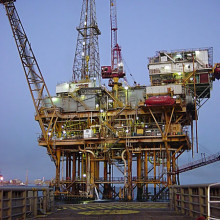
46:48 - Looking For North Sea Oil in Spain
Looking For North Sea Oil in Spain
with Jo Morris, Durham University
Jo - Basically, I study some fluvial rocks out in Central Spain, which are very similar to what they're trying to drill for oil in the North Sea, so I can go out to my field and try and map them, log them, capture the different characteristics about it and then I come back to the UK and have meetings with the companies that are sponsoring my PhD and so let them know what's going on out there. It helps give them a really good idea of what's going on in their reservoirs because if you think about it, when they drill, they only get a 10cm core, and from that 10cm core they've got to predict what's going in their reservoir that's say, five kilometres wide.
Meera - Now why does looking into the rocks you're looking into in Central Spain help them understand the ones in the North Shore? So why are they similar and how can analyzing this help them predict with the right areas to dig?
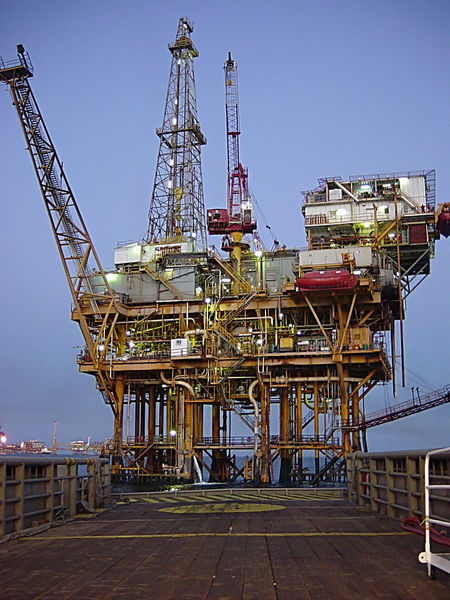 Jo - Okay. So it's a really good question. My rocks out in Spain are really good analogies for the North Sea because they're deposited at the same time. So if there are any climatic effects on the deposition of those rocks, the climatic changes would have been ocurring at the same time for both the rocks deposited in the North Sea and the rocks deposited in Spain. We're also in a tectonic basin - so with rifting, active rifting basin and all these sediments are being deposited within these basins.
Jo - Okay. So it's a really good question. My rocks out in Spain are really good analogies for the North Sea because they're deposited at the same time. So if there are any climatic effects on the deposition of those rocks, the climatic changes would have been ocurring at the same time for both the rocks deposited in the North Sea and the rocks deposited in Spain. We're also in a tectonic basin - so with rifting, active rifting basin and all these sediments are being deposited within these basins.
Meera - How does understanding the rock help people know where to dig? So what do you need to know about a rock in order to know if there's going to be oil underneath it?
Jo - Basically, the simple equation for finding oil in the North Sea and the reservoirs is you need to find sand. That's where the oil's going to be. So about 30-40 years ago when they started drilling there, it was quite easy for them because it was- the reservoirs were all sand.
Meera - So is oil always under sand everywhere?
Jo - No, it's not always in the sand. You can get it limestones as well and things like that, just primarily the reservoirs that I know about in the North Sea and the reservoirs that they've been trying to drill into.
Meera - I'm sorry I did interrupt you there. So, primarily they need to look for sand, what then?
Jo - In the case of my research, they need to look for sand, before I get shouted at by all the other geologists looking for oil in other reservoirs! But yes, so if you think about a river on a flood plain in a modern day setting, the river flowing through the system is where the sand's going to be deposited. But we've also got a flood plain that that river is flowing in through which where the muds are and that's not where you going to find oil. So over time that river will avulse over the flood plane and stack up and build, so that sand is shifting throughout the system over time, and that's what my rocks have been doing in Spain and I'm trying to map and figure out, and by doing that we can then go back and look at the reservoirs in the North Sea and hopefully try and predict where that sand is, much better.
Meera - So by finding where the sand is in the Central Spain rocks, that can help them create essentially a type of map of the North Shore rocks and then know which is the correct part to dig in?
Jo - Yeah. So what the people working in the oil industry would do is probably drill a couple of cores within their reservoir and from that 10cm core then try and build up a model, a 3D model of that reservoir. And the reservoirs can vary in size but usually they're sort of 5 to 10 kilometres squared and on also vertical distance as well to create the volume, of course. So what we try and do is we take what we found in Spain and put that information into the 3D models and in the 3D models, we have rivers flowing through and we have the mud plains in there as well. And it's all about trying to predict the volume of sand and, therefore, the volume of oil coming out as well.
Meera - So how has it gone so far? Have you actually - have they been able to find some oil in the right places yet?
Jo - Yes. So I'm actually only towards the end of the first year of my PhD so I have been - I had a couple of meetings with the people that I worked within the industry and trying to hand over the information. I've been on fieldwork in collected my data so I'll actually be analyzing that over the next year.
Meera - And how beneficial then is knowing this for the oil industry? So, I mean, obviously, they have to wait for this data so that's losing them money but then, at the same time, it's going to help them not waste money in digging in the wrong places. So how would you and them combine to balance that out?
Jo - It's just a mixture of trying to drill for oil in the short of period of time. Obviously, the industry is based on an econo - it's all about money basically, an economic potential. They obviously do have to wait for my data; but at the same time, they've got other experts in the industry. They have other people working on things like this as well and they're always getting the information fed through, and they just, whenever they have to make a decision, whenever it's time to drill, they just use the data that they have at that point.
Meera - What about the option of not telling them anywhere to dig and that way they can't and then we can solve the whole oil-fuel issue?
Jo - A lot of people do ask me this sort of question. They do wonder why you're working in the oil industry and things like that. And you just sort of point out to them that everything is based on the oil industry. If the - chair they're sitting on, if it's made from plastic, it's based on the oil industry. The cars they drive to the supermarket, the food that they buy and eat from the supermarket--all is produced from the oil industry. So it's not as simple as completely shutting off because it means we'll be going back to the Iron Ages and driving around on horse and cart and things like that. So it's finding new ways of creating energy and lowering the amount that we use in the oil industry; but it will never go away.
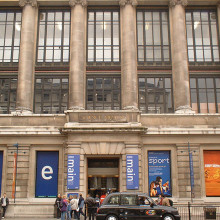
53:00 - The Punk Scientists
The Punk Scientists
with Jon Milton and Dan Carter-Hope, The Science Museum
Jon - Well, basically, what we want to do is to try to get everyone interested in science so not just sort of preaching to the converted. We want to engage everyone. Well, we don't really simplify our science. We just make shows very accessible. They're funny. They're silly. They're stupid, maybe a bit peurile.
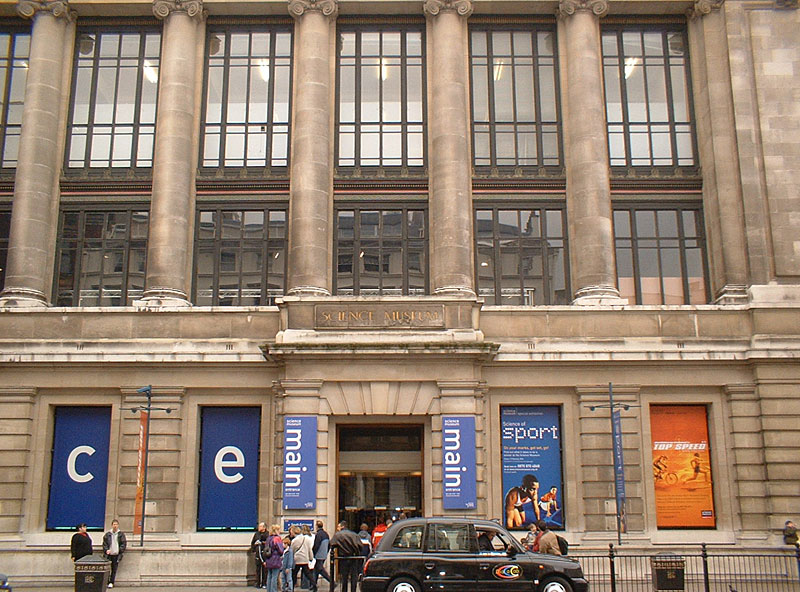 Dan - Yeah. It's the opposite of the stereotypical science show or lecture. We've gone to the opposite extreme, and it's sort of elements of pantomime. "It's a knockout" and being in a pub.
Dan - Yeah. It's the opposite of the stereotypical science show or lecture. We've gone to the opposite extreme, and it's sort of elements of pantomime. "It's a knockout" and being in a pub.
Meera - Well, because that's what I was going to ask you, because there's so many different groups now trying to make science more accessible...
Jon - Yeah.
Meera - And the whole field of science communication...
Jon - Yeah.
Meera - But what do you do that's different? Because your slogan is that, you're aimed at adults purely as your main kind of audience.
Dan - Well, yes, originally, but we've also expanded to include, I think, it's safe to say, everyone.
Jon - Yeah.
Dan - Having done kid's shows, teenage shows, adult shows and family shows. So, really, we've turned into the SWAT team of science communication.
Jon - But our main focus is adults so..
Dan - Yeah.
Jon - I mean, we do a regular gig where every month at the Science Museum in London...
Jon and Dan - The Late opening...the 'Lates', yeah.
Dan - Where we do a different show every month depending on the theme of the night. So the next one...
Jon - For example, there has been a Formula One. We've had women in science. There's been space. What else did we do?
Dan - Climate change.
Jon - Climate change is the next one, yeah.
Meera - That's your next one coming out?
Jon - Yeah.
Meera - So what aspects in climate change are you looking at there?
Jon - Oh, it's that. The mechanism; how it's going to affect our lives, crazy weather?
Dan - A bit of skewed look at it as well...
Jon - Yes.
Dan - ...because we're trying to look at local food and local produce because to break down - to bring down the carbon footprint, you should try and eat your local produce and that sort of things. So...
Meera - And do you?
Dan - Yeah, I do actually.
Jon - Yeah, I go to my local supermarket because...
Dan - No, that's not the point, man.
Meera - Do you read where it's from in the label?
Jon - I say
Dan - That sounds fun. I'll eat that--no! Yeah, I do. So, the most part, I think, practically, I don't think as many people who's need to...
Jon - No.
Dan - ...do it because of price especially in the economic climate. Can I say that without sounding dull?
Jon - No.
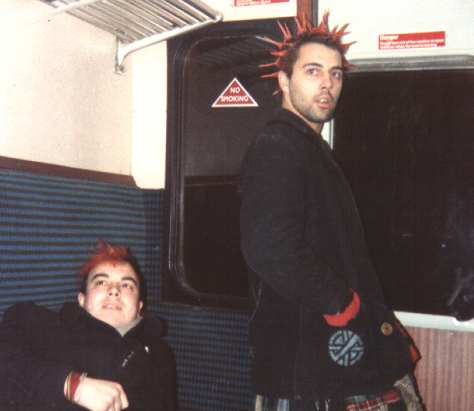 Dan - Our skewed look at that is that as a result of the temperatures going up, year on year, insects have been getting slightly larger. So our proposal is, why not eat insects?
Dan - Our skewed look at that is that as a result of the temperatures going up, year on year, insects have been getting slightly larger. So our proposal is, why not eat insects?
Jon - Yeah.
Meera - Okay.
Dan - So we get some insects...
Jon - Easy to farm.
Dan - And this is where we're showing to be hypocrites because you can only get edible insects that do come from...
Meera - They're not locally sourced then?
Dan - No. No.
John - Local to Cambodia.
Dan - Yeah, yeah. The tarantula...
Meera - Locusts...
Jon - Yes, from Cambodia.
Dan - We're making important science points. It's not just about bullying people into eating insects in the live environment.
Jon - But it's trying to get people to think in a slightly different way.
Dan - Yeah.
Meera - Well, you also reach new audiences because I've seen that you've also performed at Edinburgh Fringe and places like that.
Jon - Yes. Yeah, two years ago.
Meera - So how have they gone down?
Dan - That went down really well actually.
Jon - Yeah, very well.
Dan - We first saw that went there was Einstein Year so we may have had some help with the publicity.
Jon - Yeah, because we did a show about Newton. Yeah.
Dan - What? No, we missed a trick there!
John - Oh, next...
Dan - No, we did a show about Einstein obviously.
Jon - Yeah, went really well. It was a great experience. And that's a sort of ideal audience for us really, sort of festival-going crowd who are willing to try something a little bit unusual.
Meera - So how would you summarize then the main ways you try and engage your audience and get them kind of passionate about science?
Dan - It's through big interactive demonstrations of things.
Jon - Yes.
Dan - Because lots of people have to get involved and there maybe a degree of humiliation either for us or for them depending on how it works out.
Jon - It's all audience participation. We don't...
Dan - Voting, that sort of thing.
Jon - Because I suppose most science communicators, they just do experiments.
Dan - Yeah.
Jon - Which is great because they look brilliant and they get really good reaction...
Meera - You want interaction?
Dan - Yes.
Jon - But we actually interact with people. I suppose that's because we deal with adult audiences. So it's nice to do experiments because you get a bit of wow factor; but we found it wasn't enough and people, adults, tended to find they're being a bit patronized because most of the established experiments are targeted at children. And that wasn't our target audience. So we changed. So we took - we started to take sort of more theoretical things and tried to make them into live things, for example...
Dan - Yeah, which sometimes works really well.
Jon - Yeah, Brownian motion -we turned into a live demo...
Dan - Yeah.
Jon - Using the audience to be the molecules...
Meera - Oh, nice.
Jon - Yeah.
Dan - And beach balls...
Jon - We're getting beach balls at them and then more and more beach balls. So we try and put in this sort of "it's-a-knockout" element of escalation.
Meera - And would you say they understand the kind of science behind that?
Dan - Well, a lot of people surprisingly do. Yes, people who aren't - are necessarily into because...
Jon - A lady came up to us...
Dan - Our ringing endorsement!
Jon - Oh, yes, yeah.
Dan - Yes.
Jon - Who came up at one of the Edinburgh shows. She said she's been married to a physicist...
Dan - A physicist. It's awful.
Meera - But now she's going to understand your work?
Dan - Yeah, for the first time, she actually understood what Brownian motion meant so...
Meera - And so explain to our audience what is Brownian motion.
Dan - No.
Jon - [adopting a strange voice] It's the random movement over particles suspended in a liquid.
Dan - Yeah.
Meera - And is there - it has to be said in that voice?
Jon and Dan - It does. It does.
Meera - Yeah?
Jon - And it proves the existence of the atom. Anyway, it helped to prove the existence.
Dan - Yeah, it did. It led to proving the existence...
Jon - So we do little footnotes of...
Meera - But your backgrounds--both of yours--aren't science backgrounds?
Jon - No.
Meera - So what made you get involved with making science exciting for other people?
Jon - We worked as explainers at the Science Museum's Launch Pad Gallery.
Dan - Yeah.
Meera - It all began there?
Jon - Yes.
Dan - They recruit a lot of people for that job. They were looking for science backgrounds. They recruited a similar amount of people with performing music, comedy, drama backgrounds.
Meera - Yeah, and then lastly, and I guess the question you must get all the time because we always get asked if we're naked because we're the "Naked Scientists" so are you indeed punks, or have you ever been punks?
Jon and Dan: No. No. No. But at least you can say we are scientists. We can't even say that.
Dan - I said, no, but I have genuine interest in science.
Jon - Yeah.
Dan - But one of our former taglines, tried and tested, was that if we made things simple enough that if we can understand it, anyone can.
- Previous The Eels Massive Migration
- Next Bionic Bodies









Comments
Add a comment